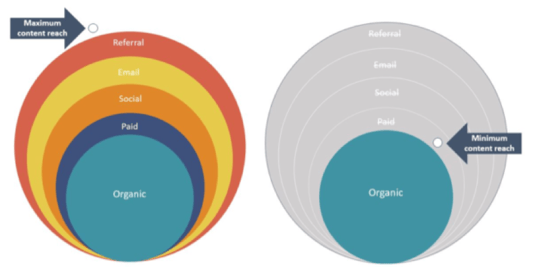Pump Up Your Outdoor Industry Brand Sales With Targeted Paid Ad Amplification in 2018
Creating great content is only the first step for your online marketing efforts. Smart marketers will tell you 20% of your resources should go into creating the content. The other 80%? Use it to promote that content. There's no question that, in the modern landscape, a big part of your marketing and sales strategy is digital (see our Digital Sales Strategies for the Outdoor Industry). Consumers and businesses alike are almost always online -- and you want to be able to reach them and observe their behavior where they spend the most time.
Today I have Sergey Dubinin with me. I think of Sergey as Mr. Amp Man a Marvel Super Hero type guy because his super power as a Paid Media Strategist at Revenue River is to bust through all the channel sirens calling you to spend your money to "amplify" your content with them. Sergey works to assure that someone does not, as Steve Miller sings, "take your money and run" leaving you with no trackable positive return on your ad investment. 
Content Amplification
R- Sergey, welcome. You have a background in Search Engine Optimization and Management through stints with some big brands, like Audi. Decision makers in an outdoor industry brand company have been hammered pretty hard about "get your organic search" results up through great content, then they get hit with, "that's not enough, you got to amplify." What is the amplification of content mean and what are the key components in your experience to a return-drive amplification strategy?
S- Successful digital marketing today must start with a company producing powerful, valuable that will assist the reader in identifying or solving a problem/challenge they face. The company must publish frequently, use a concept like 10x content, and execute solid SEO best practices as their first priority in the driving results from organic sources.
Content amplification is a term used to define ways content can be amplified, using specific channels online. Content amplification is a multichannel approach that uses paid, owned, and earned media to promote and distribute content. The goal of amplification is to increase your brand’s reach and increase the number of people moving through your sales funnel to become customers. The companies who are successful at content marketing tend to diversify their traffic sources to get the most out of the content they create.
R- Ok that seems pretty straightforward, so what should go into creating a content amplification strategy for an outdoor industry brand?
Developing a Content Amplification Strategy
S- First, the company should get a clear picture of where their leads are coming from utilizing the existing content they are creating. A tool like Google Analytics can produce reports providing information as to traffic generation from organic, paid, social, email and referral. With this type of information, they can establish goals and KPIs to use in establishing an amplification strategy. In developing their goals that are attainable using content amplification, they should determine:
- What they want their brand's content to accomplish in driving business growth?
- What is your goal for what the audience will do after consuming your content?
- Besides organic, what channels are you using right now?
- What content do you want to amplify?

Image courtesy of http://www.verticalmeasures.com/
After that they begin to determine what means and channels they want to use to amplify their content. The means to amplify include:
- Native Advertising
- Paid Advertising
- Social
- Influencer Marketing
R- Do each of these means to amplify also involve the use of multiple channels in which to deliver them to potential customers for the company?
S- Yes
Paid Advertising as a Component of Content Amplification
R- Let's dive in on this paid advertising component of amplifying content. What is it and is it still perceived by consumers as reflecting negatively on a company who uses it?
S- Digital advertising isn't inherently bad. In fact, targeted spend can help certain pieces of content get unprecedented amplification when you find an efficient CPC. If it seems like this feeds into the initial problem that drove you to content marketing in the first place, consider this use case for paid content distribution:
You've written a blog post that has wide appeal beyond just your target audience. You test promotion of that blog post via a paid Facebook ad, and find that the CPC is lower than your typical paid expenditures, and is driving 40% more site traffic than those typical expenditures. Even so, when you turn off that budget you lose that traffic ... right? Right. But you still received a huge influx of traffic that, even if none of them convert to leads, might have spurred either inbound links or social shares -- both of which will help bolster your SEO.
Promoting every piece of content with paid budget is untenable, but finding opportunities to do it efficiently may help you improve organically, too.
Thanks to Facebook Advertising, StumbleUpon Ads, Promoted Tweets, and other social media advertising, businesses can put their content in front of social media audiences. This is a great way to generate traffic to your website, fans for your Facebook page, and visibility for your messages on social media platforms.
While the above-mentioned points may make you believe that one strategy is better than another, there is one good reason you want to invest your time, money, and efforts into both search engine marketing and social media marketing. You simply don’t want to put all of your eggs in one basket. Take for example:
- The average conversion rate in AdWords across all industries is 2.7% on the search network and 0.89% on the display network.
- A measly 15% of all clicks – Going to the Google Paid Ads (PPC), or trying a different search. Or giving up. That’s pretty staggering. If you think you are getting the most bang for your buck with your Google Adwords campaign, you are dead wrong. You are paying for high-cost ads that may provide instant gratification, but in the
end provide zero long-term investment or value for search visibility. - Who are those 6 percent clicking on PPC ads? Women (53% of them) are more likely to click on paid search ads than men, who click on ads 47 percent of the time.
- Age also is a factor. Younger searches are less likely to click on paid ads – 35 percent of ads are clicked on by searchers age 34 or younger. But as age increases so does the number of people clicking on those ads, as 65 percent of ad clicks come from searchers age 35 and older.
- Video ads have an average clickthrough rate of 1.84%, the highest clickthrough rate of all digital ad formats. (Business Insider, 2014)
R- It seems like without years of experience and the ability to keep track of all the changes taking place in consumer shopping habits, deciding where, when, how much to spend would be a difficult decision for humans deciding on paid advertising. Is there a tool in 2017 available that can assist companies with doing a better job in developing a paid search campaign to amplify its content that is measurable?
Use a Platform Like SRAX to Improve Your Spend on Paid Advertising
S- Yes, we are utilizing a set of tools through SRAX.
R- What are the tools you have integrated from SRAX and how do they work?
S- The company's first product, GroupAd, is a brand loyalty platform that provides instant rewards and feedbacks for consumers. The backbone of loyalty shows brands who their influencers are so that they can utilize this information to further hence their marketing efforts. GroupAd as a consumer facing product is a suit of marketing applications.
The second product released by the company is SRAX, a platform built to aggregate and optimize the disperse real time bidding channel so that publishers could utilize this revenue channel more effectively. Early on it focused on the selling side of the Programmatic Advertising market and it built its capabilities and expertise on the buying side as well by developing state of the art algorithm and practices to optimize the bid and targeting relationship.
Both Social Reality businesses complement each other. Brands' advertisement attain their social marketing campaigns through traditional media purchased through the buy side of the SRAX platform. GroupAd provides extensive audience data that brands can target for their ads through the SRAX platform. Ultimately SRAX and GroupAd merge toward Social Reality vision which is to both automate and make digital ads available, affordable and efficient for all brands' markets and businesses of any size.
R- Does SRAX offer demonstrations of these services in action?
S- Yes
R- What other trends do you see for the rest of 2017 with regard to paid search as a component of amplifying a company's content?
S- More use of AI to develop understanding of what is going on in the marketplace and make recommendations to buyers on where, when and how to use paid amplification.
R- How important do you see your partnership with a company like SRAX being in the work you do for clients?
S- I believe good partnerships make successful marketing campaigns. Our partnership with SRAX is an example of what we do as a digital marketing agency in developing good partnerships with "best of breed" technology companies to help outdoor industry brand companies improve the performance of their content and deliver customers who engage and purchase. It's also critical to me in establishing a good partnership with outdoor industry brand companies we work with to get the most out their digital marketing spend.
R- What about an example?
S- Here is one from Shopifythat is an outdoor brand.
R- In summary....
S- Spending money for paid advertising does not have the negative connotation it did only a few years ago. Paid advertising to amplify your content is now an acceptable and critical element in any digital marketing strategy. By investing this way, you reach people where they already are. Social media is also a great way to create one-on-one, personal connections with the people you want as customers.
Of course, if you put your money into marketing, you need to know what works and what doesn’t. This doesn’t mean rely on what you think works and doesn’t. Look at the numbers and know. Make sure all of your tracking is set up correctly in Google Analytics. This is one way a company can truly track how they are doing with their advertising efforts and constantly be adjusting based on real data. Be data driven.
Learn more about Sergey and his skills in:
- Campaign Development and Optimization
- Paid Media Strategy
- Amplification Strategy



